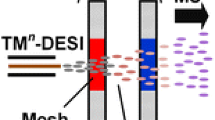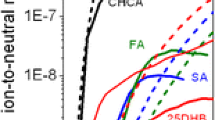Abstract
Thermally accelerated oxidative degradation of aqueous quercetin at pH 5.9 and 7.4 was kinetically measured using an in-house built online continuous flow device made of concentric capillary tubes, modified to fit to the inlet of an electrospray ionization-ion trap-time-of-flight-mass spectrometer (ESI-IT-TOF-MS). Time-resolved mass spectral measurements ranging from 2 to 21 min were performed in the negative mode to track intermediate degradation products and to evaluate the degradation rate of the deprotonated quercetin ion, [Q-H]–. Upon heating solutions in the presence of dissolved oxygen, degradation of [Q-H]– was observed and was accelerated by an increase in pH and temperature. Regardless of the condition, the same degradation pathways were observed. Degradation mechanisms and structures were determined using higher order tandem mass spectrometry (up to MS3) and high mass accuracy. The observed degradation mechanisms included oxidation, hydroxylation, and ring-cleavage by nucleophilic attack. A chalcan-trione structure formed by C-ring opening after hydroxylation at C2 was believed to be a precursor for other degradation products, formed by hydroxylation at the C2, C3, and C4 carbons from attack by nucleophilic species. This resulted in A-type and B-type ions after cross-ring cleavage of the C-ring. Based on time of appearance and signal intensity, nucleophilic attack at C3 was the preferred degradation pathway, which generated 2,4,6-trihydroxymandelate and 2,4,6-trihydroxyphenylglyoxylate ions. Overall, 23 quercetin-related ions were observed.

ᅟ







Similar content being viewed by others
References
Knekt, P., Kumpulainen, J., Jarvinen, R., Rissanen, H., Heliovaara, M., Reunanen, A., Hakulinen, T., Aromaa, A.: Flavonoid intake and risk of chronic diseases. Am. J. Clin. Nutr. 76, 560–568 (2002)
Mink, P.J., Scrafford, C.G., Barraj, L.M., Harnack, L., Nettleton, A.J., Jacobs, D.R.: Flavonoid intake and cardiovascular disease mortality: a prospective study in postmenopausal women. Am. J. Clin. Nutr. 85, 895–909 (2007)
Sesso, H.D., Gaziano, J.M., Liu, S., Buring, J.E.: Flavonoid intake and the risk of cardiovascular disease in women. Am. J. Clin. Nutr. 77, 1400–1408 (2003)
Cassidy, A., Rimm, E.B., O’Reilly, E.J., Logroscino, G., Kay, C., Chiuve, S.E., Rexrode, K.M.: Dietary flavonoids and risk of stroke in women. Stroke 43, 946–951 (2012)
Pourcel, L., Routaboul, J.M., Cheynier, V., Lepiniec, L., Debeaujon, I.: Flavonoid oxidation in plants: from biochemical properties to physiological functions. Trends Plant Sci. 12, 29–36 (2007)
Makris, D.P., Rossiter, J.T.: Heat-induced metal-catalyzed oxidative degradation of quercetin and rutin (quercetin-3-o-rhamnosylglucoside) in aqueous model systems. J. Agric. Food Chem. 48, 3830–3838 (2000)
Buchner, N., Krumbein, A., Rohn, S., Kroh, L.W.: Effect of thermal processing on the flavonols rutin and quercetin. Rapid Commun. Mass Spectrom. 20, 3229–3235 (2006)
Zhang, M., Chen, H., Li, J., Pei, Y., Liang, Y.: Antioxidant properties of tartary buckwheat extracts as affected by different thermal processing methods. Lebensmittel-Wissenschaft Technol. 43, 181–185 (2010)
Xu, B., Chang, S.K.C.: Total phenolic, phenolic acid, anthocyanin, flavan-3-ol, and flavonol profiles and antioxidant properties of pinto and black beans (Phaseolus vulgaris L.) as affected by thermal processing. J. Agric. Food Chem. 57, 4754–4764 (2009)
Barnes, J.S., Nguyen, H.P., Shen, S., Schug, K.A.: General method for extraction of blueberry anthocyanins and identification using high performance liquid chromatography–electrospray ionization-ion trap-time of flight-mass spectrometry. J. Chromatogr. A 1216, 4728–4735 (2009)
Makris, D.P., Rossiter, J.T.: Hydroxyl free radical-mediated oxidative degradation of quercetin and morin: a preliminary investigation. J. Food Comp. Anal. 15, 103–113 (2002)
Ou, B., Hampsch-Woodill, M., Prior, R.L.: Development and validation of an improved oxygen radical absorbance capacity assay using fluorescein as the fluorescent probe. J. Agric. Food Chem. 49, 4619–4626 (2001)
Pulido, R., Bravo, L., Saura-Calixto, F.: Antioxidant activity of dietary polyphenols as determined by a modified ferric reducing/antioxidant power assay. J. Agric. Food Chem. 48, 3396–3402 (2000)
Benzie, I.F.F., Strain, J.J.: The ferric reducing ability of plasma (FRAP) as a measure of “antioxidant power”: the FRAP Asay. Anal. Biochem. 239, 70–76 (1996)
Chien, J.T., Hsu, D.J., Inbaraj, B.S., Chen, B.H.: Integral kinetic model for studying quercetin degradation and oxidation as affected by cholesterol during heating. Int. J. Mol. Sci. 11, 2805–2820 (2010)
López-Alarcón, C., Denicola, A.: Evaluating the antioxidant capacity of natural products: a review on chemical and cellular-based assays. Anal. Chim. Acta 763, 1–10 (2013)
Makris, D.P., Rossiter, J.T.: An investigation on structural aspects influencing product formation in enzymatic and chemical oxidation of quercetin and related flavonols. Food Chem. 77, 177–185 (2002)
Krishnamachari, V., Levine, L.H., Pare, P.W.: Flavonoid oxidation by the radical generator AIBN: a unified mechanism for quercetin radical scavenging. J. Agric. Food Chem. 50, 4357–4363 (2002)
Zenkevich, I.G., Eshchenko, A.Y., Makarova, S.V., Vitenberg, A.G., Dobryakov, Y.G., Utsal, V.A.: Identification of the products of oxidation of quercetin by air oxygen at ambient temperature. Molecules 12, 654–672 (2007)
Pinelo, M., Manzocco, L., Nunez, M.J., Nicoli, M.C.: Solvent effect on quercetin antioxidant capacity. Food Chem. 88, 201–207 (2004)
Zhou, A., Kikandi, S., Sadik, O.A.: Electrochemical degradation of quercetin: isolation and structural elucidation of the degradation products. Electrochem. Commun. 9, 2246–2255 (2007)
Zhou, A., Sadik, O.A.: Comparative analysis of quercetin oxidation by electrochemical, enzymatic, autoxidation, and free radical generation techniques: a mechanistic study. J. Agric. Food Chem. 56, 12081–12091 (2008)
Clarke, D.J., Stokes, A.A., Langridge-Smith, P., Mackay, C.L.: Online quench-flow electrospray ionization Fourier transform ion cyclotron resonance mass spectrometry for elucidating kinetic and chemical enzymatic reaction mechanisms. Anal. Chem. 82, 1897–904 (2010)
Northrop, D.B., Simpson, F.B.: New concepts in bioorganic chemistry beyond enzyme kinetics: direct determination of mechanisms by stopped-flow mass spectrometry. Bioorg. Med. Chem. 5, 641–644 (1997)
Orsnes, H., Graf, T., Degn, H.: stopped-flow mass spectrometry with rotating ball inlet: application to the ketone-sulfite reaction. Anal. Chem. 70, 4751–4754 (1998)
Kolakowski, B.M., Simmons, D.A., Konermann, L.: Stopped-flow electrospray ionization mass spectrometry: a new method for studying chemical reaction kinetics in solution. Rapid Commun. Mass Spectrom. 14, 772–776 (2000)
Kolakowski, B.M., Konermann, L.: From small molecule reactions to protein folding: studying biochemical kinetics by stopped-flow electrospray mass spectrometry. Anal. Biochem. 292, 107–114 (2001)
Konermann, L., Collings, B.A., Douglas, D.J.: Cytochrome c folding kinetics studied by time-resolved electrospray ionization mass spectrometry. Biochemistry 36, 5554–5559 (1997)
Zechel, D.L., Konermann, L., Withers, S.G., Douglas, D.J.: Pre-steady state kinetic analysis of an enzymatic reaction monitored by time-resolved electrospray ionization mass spectrometry. Biochemistry 37, 7664–7669 (1998)
Lee, V.W.S., Chen, Y.L., Konermann, L.: Reconstitution of acid-denatured holomyoglobin studied by time-resolved electrospray ionization mass spectrometry. Anal. Chem. 71, 4154–4159 (1999)
Sogbein, O.O., Simmons, D.A., Konermann, L.: Effects of pH on the kinetic reaction mechanism of myoglobin unfolding studied by time-resolved electrospray ionization mass spectrometry. J. Am. Soc. Mass Spectrom. 11, 312–319 (2000)
Wilson, D.J., Konermann, L.: A capillary mixer with adjustable reaction chamber volume for millisecond time resolved studies by electrospray mass spectrometry. Anal. Chem. 75, 6408–6414 (2003)
Barnes, J.S., Schug, K.A.: structural characterization of cyanidin-3,5-diglucoside and pelargonidin-3,5-diglucoside anthocyanins: multi-dimensional fragmentation pathways using high performance liquid chromatography-electrospray ionization-ion trap-time of flight mass spectrometry. Int. J. Mass Spectrom 38, 71–80 (2011)
Tedmon, L., Barnes, J.S., Nguyen, H.P., Schug, K.A.: Differentiating isobaric steroid hormone metabolites using multi-stage tandem mass spectrometry. J. Am. Soc. Mass Spectrom. 24, 399–409 (2013)
Medvidović-Kosanović, M., Šeruga, M., Jakobek, L., Novak, I.: Electrochemical and antioxidant properties of (+)-catechin, quercetin and rutin. Croat. Chem. Acta 83, 197–207 (2010)
Jovanovic, S.V., Steenken, S., Tosic, M., Marjanovic, B., Simic, M.G.: Flavonoids as Antioxidants. J. Am. Chem. Soc. 116, 4846–4851 (1994)
Lemanska, K., Woude, H.V.D., Szymusiak, H., Boermsa, M.G., Gliszczynsak-Swiglo, A., Rietjens, I.M.C.M., Tyrakowska, B.: Free Radic. Res. 38, 639–647 (2004)
Wang, G., Cole, R.B.: Disparity between solution-phase equilibria and charge state distributions in positive-ion electrospray mass spectrometry. Org. Mass Spectrom. 29, 419–427 (1994)
Schug, K.A., McNair, H.M.: Adduct formation in electrospray ionization mass spectrometry II. Benzoic acid derivatives. J. Chromatogr. A 985, 531–539 (2003)
Gudkov, S.V., Karp, O.E., Garmash, S.A., Ivanov, V.E., Chernikov, A.V., Manokhin, A.A., Astashev, M.E., Yaguzhinsky, L.S., Bruskov, V.I.: Generation of reactive oxygen species in water under exposure to visible or infrared irradiation at absorption bands of molecular oxygen. Biophysics 57, 1–8 (2012)
Lei, R., Xu, X., Yu, F., Li, N., Liu, H., Li, K.: A method to determine quercetin by enhanced luminol electrogenerated chemiluminescence (ECL) and quercetin autoxidation. Talanta 75, 1068–1074 (2008)
Jørgensen, L.V., Cornett, C., Justesen, U., Skibsted, L.H., Dragsted, L.O.: Two-electron electrochemical oxidation of quercetin and kaempferol changes only the flavonoid C-ring. Free Radic. Res. 29, 339–350 (1998)
Tournaire, C., Hocquaux, M., Beck, I., Oliveros, E., Maurette, M.: Activite Anti-Oxidante de Flavonoides Reactivite Avec le Superoxyde de Potassium en Phase Heterogene. Tetrahedron 50, 9303–9314 (1994)
Yonekawa, M., Furusho, Y., Sei, Y., Takata, T., Endo, T.: Synthesis and X-ray structural analysis of an acyclic bifunctional vicinal triketone, its hydrate, and its ethanol-adduct. Tetrahedron 69, 4076–4080 (2013)
Mecinovic, J.R., Hamed, B., Schofield, C.J.: Iron-mediated cleavage of C–C bonds in vicinal tricarbonyl compounds in water. Angew. Chem. Int. Ed. 48, 2796–2800 (2009)
Wasserman, H.H., Parr, J.: The chemistry of vicinal tricarbonyls and related systems. Acc. Chem. Res. 37, 687–701 (2004)
Acknowledgments
The authors gratefully acknowledge Shimadzu Scientific Instruments, Inc. for their support of instrumentation through the Shimadzu Equipment Grants for Research Program.
Author information
Authors and Affiliations
Corresponding author
Rights and permissions
About this article
Cite this article
Barnes, J.S., Foss , F.W. & Schug, K.A. Thermally Accelerated Oxidative Degradation of Quercetin Using Continuous Flow Kinetic Electrospray-Ion Trap-Time of Flight Mass Spectrometry. J. Am. Soc. Mass Spectrom. 24, 1513–1522 (2013). https://doi.org/10.1007/s13361-013-0698-6
Received:
Revised:
Accepted:
Published:
Issue Date:
DOI: https://doi.org/10.1007/s13361-013-0698-6




